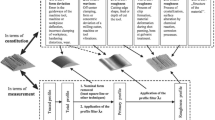Abstract
Lathes and other turning machines are widely used in the metalworking and manufacturing sector which are powered by induction motors and subject to disturbances in power quality. The dimensions and surface roughness of turned parts produced by these machines are a function of the machining parameters, material properties of the parts and tools, and tool geometry. The surface roughness of machined parts varies with changes in the electromagnetic torque on the motor shaft, and it is considered one of the main indices of finished product quality. This paper seeks to present artificial neural networks as a surface roughness predictor for turned parts, based on the values of the effective current feeding a three-phase induction motor in a machining process. Simulation and experimental results are presented to validate the performance of the proposed method under different unbalanced voltage and machining conditions.










Similar content being viewed by others
References
Abellan-Nebot, J. V., & Romero Subirón, F. (2010). A review of machining monitoring systems based on artificial intelligence process models. The International Journal of Advanced Manufacturing Technology, 47(1), 237–257.
Ahilan, C., Kumanan, S., Sivakumaran, N., & Dhas, J. E. R. (2013). Modeling and prediction of machining quality in CNC turning process using intelligent hybrid decision making tools. Applied Soft Computing, 13(3), 1543–1551.
Asilturk, I., & Çunkas, M. (2011). Modeling and prediction of surface roughness in turning operations using artificial neural network and multiple regression method. Expert Systems with Applications, 38(5), 5826–5832.
Asilturk, I., & Unuvar, A. (2010). Development of a neural network based surface roughness prediction system using cutting parameters and an accelerometer in turning. In 2010 IEEE international conference on electro/information technology (pp. 1–4).
Benardos, P., & Vosniakos, G. C. (2003). Predicting surface roughness in machining: A review. International Journal of Machine Tools and Manufacture, 43(8), 833–844.
Feng, C. X. J., & Wang, X. F. D. (2003). Surface roughness predictive modeling: Neural networks versus regression. IIE Transactions, 35(1), 11–27.
Grzenda, M., & Bustillo, A. (2013). The evolutionary development of roughness prediction models. Applied Soft Computing, 13(5), 2913–2922.
Haykin, S. S., Haykin, S. S., Haykin, S. S., & Haykin, S. S. (2009). Neural networks and learning machines (Vol. 3). Upper Saddle River, NJ: Pearson.
Huang, J., Zhang, W., & Chen, R. (2011). Selection and processing of surface roughness for mechanical parts. In 2011 international conference on electronic and mechanical engineering and information technology (EMEIT) (Vol. 8, pp. 4258–4261). IEEE.
Jian, Z., & Jin, Z. (2010). Surface roughness measure based on average texture cycle. In 2010 2nd international conference on intelligent human-machine systems and cybernetics (IHMSC) (Vol. 2, pp. 298–302). IEEE.
Jovic, S., Anicic, O., & Jovanovic, M. (2017). Adaptive neuro-fuzzy fusion of multi-sensor data for monitoring of cnc machining. Sensor Review, 37(1), 78–81.
Kalos, P., Nandurkar, K., & Navale, L. (2007). Control of roundness on turned cylindrical bars using artificial neural network. In 2007 IEEE international conference on industrial engineering and engineering management (pp. 597–601). IEEE.
Kamarthi, S., Sultornsanee, S., & Zeid, A. (2016). Recurrence quantification analysis to estimating surface roughness in finish turning processes. The International Journal of Advanced Manufacturing Technology, 87(1), 451–460.
Karpat, Y., & Özel, T. (2005). Hard turning optimization using neural network modeling and swarm intelligence. Transactions of NAMRI/SME, 33, 179–186.
Karpat, Y., & Özel, T. (2006). Swarm-intelligent neural network system (sinns) based multi-objective optimization of hard turning. Transactions of NAMRI/SME, 38, 9–16.
Karpat, Y., & Özel, T. (2007). Multi-objective optimization for turning processes using neural network modeling and dynamic-neighborhood particle swarm optimization. The International Journal of Advanced Manufacturing Technology, 35(3), 234–247.
Krause, P. C., Wasynczuk, O., Sudhoff, S. D., & Pekarek, S. (2013). Analysis of electric machinery and drive systems (Vol. 75). London: Wiley.
Makadia, A. J., & Nanavati, J. (2013). Optimisation of machining parameters for turning operations based on response surface methodology. Measurement, 46(4), 1521–1529.
Nakai, M. E., Júnior, H. G., Aguiar, P. R., Bianchi, E. C., & Silva, P. S. D. (2015). Evaluation of neural models to estimate the roughness of advanced ceramics in surface grinding. International Journal of Machining and Machinability of Materials, 17(5), 454–479.
Ong, C. M. (1998). Dynamic simulation of electric machinery: Using MATLAB/SIMULINK. Upper Saddle River, NJ: Prentice Hall.
Özel, T., & Karpat, Y. (2005). Predictive modeling of surface roughness and tool wear in hard turning using regression and neural networks. International Journal of Machine Tools and Manufacture, 45, 467–479.
Paczkowski, T., & Zdrojewski, J. (2017). Monitoring and control of the electrochemical machining process under the conditions of a vibrating tool electrode. Journal of Materials Processing Technology, 244, 204–214.
Pontes, F. J., Ferreira, J. R., Silva, M. B., Paiva, A. P., & Balestrassi, P. P. (2010). Artificial neural networks for machining processes surface roughness modeling. The International Journal of Advanced Manufacturing Technology, 49(9), 879–902.
Svalina, I., Simunovic, G., Saric, T., & Lujic, R. (2017). Evolutionary neuro-fuzzy system for surface roughness evaluation. Applied Soft Computing, 52, 593–604.
Upadhyay, V., Jain, P., & Mehta, N. (2013). In-process prediction of surface roughness in turning of Ti–6Al–4V alloy using cutting parameters and vibration signals. Measurement, 46(1), 154–160.
Zainal, N., Zain, A. M., Radzi, N. H. M., & Othman, M. R. (2016). Glowworm swarm optimization (GSO) for optimization of machining parameters. Journal of Intelligent Manufacturing, 27(4), 797–804.
Acknowledgements
The authors wish to thank Araucaria Foundation (Process No. 06/56093-3), and CNPq (Process No. 474290/2008-5, No. 473576/2011-2 and No. 552269/2011-5) for their support.
Author information
Authors and Affiliations
Corresponding author
Rights and permissions
About this article
Cite this article
Mizuyama, D., da Silva, C.E., Goedtel, A. et al. Neural Predictor for Surface Roughness of Turned Parts. J Control Autom Electr Syst 29, 360–370 (2018). https://doi.org/10.1007/s40313-018-0376-9
Received:
Revised:
Accepted:
Published:
Issue Date:
DOI: https://doi.org/10.1007/s40313-018-0376-9




